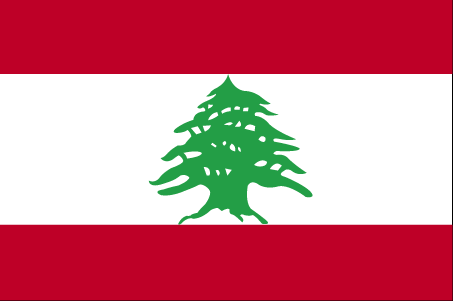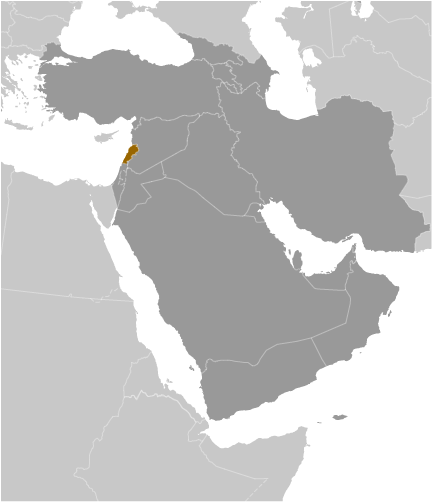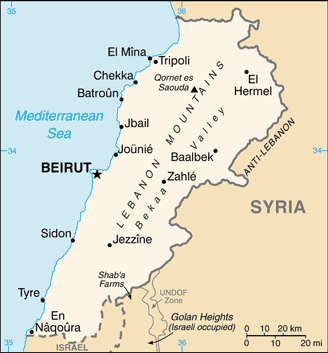|
Economy - overview:
|

|
|
Lebanon has a free-market economy and a strong laissez-faire commercial tradition. The government does not restrict foreign investment; however, the investment climate suffers from red tape, corruption, arbitrary licensing decisions, complex customs procedures, high taxes, tariffs, and fees, archaic legislation, and weak intellectual property rights. The Lebanese economy is service-oriented; main growth sectors include banking and tourism. The 1975-90 civil war seriously damaged Lebanon's economic infrastructure, cut national output by half, and derailed Lebanon's position as a Middle Eastern entrepot and banking hub. Following the civil war Lebanon rebuilt much of its war-torn physical and financial infrastructure by borrowing heavily - mostly from domestic banks - saddling the government with a huge debt burden. Pledges of economic and financial reforms made at separate international donor conferences during the 2000s have mostly gone unfulfilled, including those made during the Paris III Donor Conference in 2007 following the July 2006 war. The collapse of the government in early 2011 over its backing of the Special Tribunal for Lebanon and unrest in neighboring Syria slowed economic growth to the 1-2% range in 2011-12, after four years of 8% average growth. In September 2011 the Cabinet endorsed a bill that would provide $1.2 billion in funding to improve Lebanon's downtrodden electricity sector, but fiscal limitations will test the government's ability to invest in other areas, such as water.
|
|
|
GDP (purchasing power parity):
|

|
|
$63.69 billion (2012 est.)
country comparison to the world: 88
$62.44 billion (2011 est.)
$61.52 billion (2010 est.)
note:
data are in 2012 US dollars
|
|
|
GDP (official exchange rate):
|

|
|
$41.77 billion (2012 est.)
|
|
|
GDP - real growth rate:
|

|
|
2% (2012 est.)
country comparison to the world: 137
1.5% (2011 est.)
7% (2010 est.)
|
|
|
GDP - per capita (PPP):
|

|
|
$15,900 (2012 est.)
country comparison to the world: 83
$15,800 (2011 est.)
$15,700 (2010 est.)
note:
data are in 2012 US dollars
|
|
|
GDP - composition by sector:
|

|
|
agriculture: 4.6%
industry:
19.7%
services:
75.8% (2012 est.)
|
|
|
Labor force:
|

|
|
1.481 million
country comparison to the world: 131
note:
in addition, there are as many as 1 million foreign workers (2007 est.)
|
|
|
Labor force - by occupation:
|

|
|
agriculture: NA%
industry:
NA%
services:
NA%
|
|
|
Unemployment rate:
|

|
|
NA%
|
|
|
Population below poverty line:
|

|
|
28% (1999 est.)
|
|
|
Household income or consumption by percentage share:
|

|
|
lowest 10%: NA%
highest 10%:
NA%
|
|
|
Investment (gross fixed):
|

|
|
34% of GDP (2012 est.)
country comparison to the world: 15
|
|
|
Budget:
|

|
|
revenues: $9.317 billion
expenditures:
$12.57 billion (2012 est.)
|
|
|
Taxes and other revenues:
|

|
|
22.3% of GDP (2012 est.)
country comparison to the world: 139
|
|
|
Budget surplus (+) or deficit (-):
|

|
|
-7.8% of GDP (2012 est.)
country comparison to the world: 196
|
|
|
Public debt:
|

|
|
127.9% of GDP (2012 est.)
country comparison to the world: 6
134% of GDP (2011 est.)
note:
data cover central government debt, and exclude debt instruments issued (or owned) by government entities other than the treasury; the data include treasury debt held by foreign entities; the data include debt issued by subnational entities, as well as intra-governmental debt; intra-governmental debt consists of treasury borrowings from surpluses in the social funds, such as for retirement, medical care, and unemployment
|
|
|
Inflation rate (consumer prices):
|

|
|
5.5% (2012 est.)
country comparison to the world: 150
5.1% (2011 est.)
|
|
|
Central bank discount rate:
|

|
|
3.5% (31 December 2010 est.)
country comparison to the world: 26
10% (31 December 2009 est.)
|
|
|
Commercial bank prime lending rate:
|

|
|
7.3% (31 December 2012 est.)
country comparison to the world: 122
7.53% (31 December 2011 est.)
|
|
|
Stock of narrow money:
|

|
|
$4.397 billion (31 December 2012 est.)
country comparison to the world: 105
$4.072 billion (31 December 2011 est.)
|
|
|
Stock of broad money:
|

|
|
$97.04 billion (31 December 2011 est.)
country comparison to the world: 56
$92 billion (31 December 2010 est.)
|
|
|
Stock of domestic credit:
|

|
|
$73.83 billion (31 December 2012 est.)
country comparison to the world: 60
$69.65 billion (31 December 2011 est.)
|
|
|
Market value of publicly traded shares:
|

|
|
$10.16 billion (31 December 2011)
country comparison to the world: 68
$12.59 billion (31 December 2010)
$12.89 billion (31 December 2009)
|
|
|
Agriculture - products:
|

|
|
citrus, grapes, tomatoes, apples, vegetables, potatoes, olives, tobacco; sheep, goats
|
|
|
Industries:
|

|
|
banking, tourism, food processing, wine, jewelry, cement, textiles, mineral and chemical products, wood and furniture products, oil refining, metal fabricating
|
|
|
Industrial production growth rate:
|

|
|
2.1% (2010 est.)
country comparison to the world: 111
|
|
|
Current account balance:
|

|
|
-$7.85 billion (2012 est.)
country comparison to the world: 172
-$4.163 billion (2011 est.)
|
|
|
Exports:
|

|
|
$5.655 billion (2012 est.)
country comparison to the world: 108
$5.386 billion (2011 est.)
|
|
|
Exports - commodities:
|

|
|
jewelry, base metals, chemicals, miscellaneous consumer goods, fruit and vegetables, tobacco, construction minerals, electric power machinery and switchgear, textile fibers, paper
|
|
|
Exports - partners:
|

|
|
UAE 13.1%, Iraq 8.4%, Saudi Arabia 7.7%, Turkey 7%, Syria 6.7%, Switzerland 5.5% (2011)
|
|
|
Imports:
|

|
|
$20.73 billion (2012 est.)
country comparison to the world: 77
$19.3 billion (2011 est.)
|
|
|
Imports - commodities:
|

|
|
petroleum products, cars, medicinal products, clothing, meat and live animals, consumer goods, paper, textile fabrics, tobacco, electrical machinery and equipment, chemicals
|
|
|
Imports - partners:
|

|
|
US 10.2%, Italy 9.3%, France 8.8%, China 8.2%, Egypt 5.3%, Germany 5.1%, Turkey 4% (2011)
|
|
|
Reserves of foreign exchange and gold:
|

|
|
$51.2 billion (31 December 2012 est.)
country comparison to the world: 36
$48.14 billion (31 December 2011 est.)
|
|
|
Debt - external:
|

|
|
$32.64 billion (31 December 2012 est.)
country comparison to the world: 68
$29.47 billion (31 December 2011 est.)
|
|
|
Stock of direct foreign investment - at home:
|

|
|
$NA
|
|
|
Stock of direct foreign investment - abroad:
|

|
|
$NA
|
|
|
Exchange rates:
|

|
|
Lebanese pounds (LBP) per US dollar -
1,507.5 (2012 est.)
1,507.5 (2011 est.)
1,507.5 (2010 est.)
1,507.5 (2009)
1,507.5 (2008)
|
|
|
Fiscal year:
|

|
|
calendar year
|
|
|
|





 )
)



